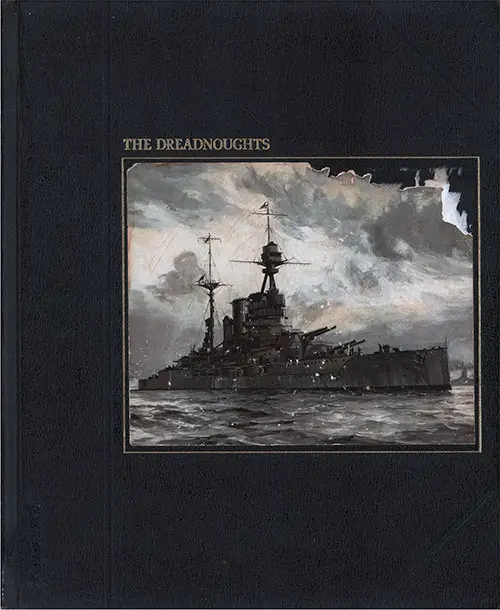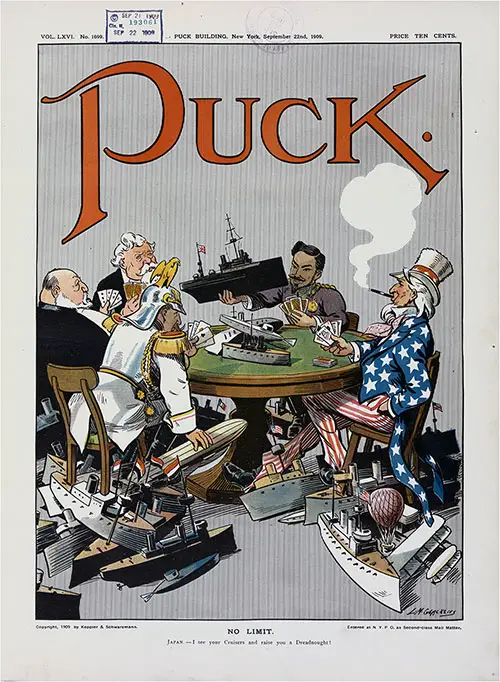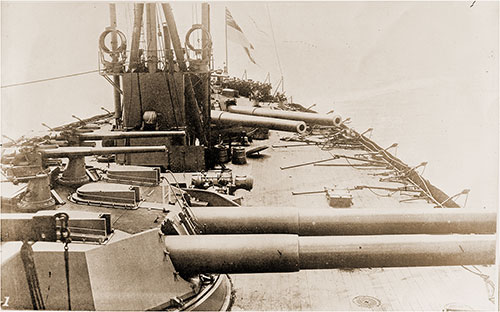The Dreadnaughts by David Howarth - 1979

Front Cover, The Dreadnoughts by David Armine Howarth and the Editors of Time-Life Books, 1979. The apogee of World War I battleship design, the superdreadnought Queen Elizabeth displays her might and majesty in this postwar painting by Oscar Parkes. Mounting eight immense 15-inch guns, she could fire a barrage 15 times heavier than that of Admiral Nelson’s flagship Victory in 1805 at Trafalgar. GGA Image ID # 18135a3846
The Dreadnought’s performance on sea trials was nothing short of sensational. From Portsmouth she steamed south to the Mediterranean, then shaped a course across the Atlantic to Trinidad, and back again. With her turbines she proved fully capable of steaming at her promised top speed of 21 knots; even more remarkable, she made the return trip from the West Indies, a total of nearly 7,000 miles on a round-about course, at an average speed of 17.5 knots, with no mechanical breakdown—an achievement no ship with reciprocating engines had ever equaled.
The most suspenseful moment of the trials came when it was time to fire her 12-inch guns, eight to the broadside. It was a moment that Sir Philip Watts, as director of the Portsmouth shipyards that had turned her out, awaited with trepidation. “He looked very grave and serious,’’ wrote one officer who was present, “and I am quite sure that he fully expected the decks to come down wholesale. Presently there was a muffled roar and a bit of a kick on the ship. The eight guns had been fired and scores of men between decks had no idea what had happened.” That “bit of a kick” had hurled a total of 21,250 pounds of shell 8,000 yards.
-- Excerpt from The Dreadnoughts
Contents
- Chapter 1: a Teutonic Challenge To Britannia's Rule
- Essay: Training for a New Era of Ships Without Sails
- Chapter 2: The Fabulous Fleet That Jacky Built
- Essay: Artful Appeals To a Nation at War
- Chapter 3: The Long Wait for Armageddon
- Essay: Mine Warfare: Seeds of Death Planted in the Sea
- Chapter 4: A Fierce Skirmish of Scouts at Jutland
- Chapter 5: A Duel of Dreadnoughts: 50 Minutes of Fury
- Essay: The Drama of Jutland Through a German's Eyes
- Chapter 6: Dishonor and Suicide for the Kaiser's Navy
- Bibliography
- Picture Credits
- Acknowledgments
- Index
About the Author
David Howarth brings to his books a practical knowledge of ships and the sea. During World War II he served as a lieutenant commander in the Royal Navy and spent four years in the Shetland Islands organizing fishing boats with crews of Norwegian volunteers to land agents and arms in occupied Norway. After the War he designed and built boats, before turning to writing full time. His books include Trafalgar, and, in the Seafarers series, The Men-of-War.

Front Cover, Puck Magazine, 22 September 1909, Published by Keppler & Schwarzmann, New York. Illustration shows a high-stakes poker game with Uncle Sam, William II, the German Emperor, Meiji, the Emperor of Japan, Armand Fallières, President of France, and Edward VII, King of Great Britain; the emperor of Japan is raising the bid by one battleship. Library of Congress LC 2011647506. GGA Image ID # 1813f9e563
What is a Dreadnought?

Photograph Shows the HMS Dreadnought. Quarterdeck of Dreadnought Cleared for Action, ca 1915. Photograph by Bains News Service. Library of Congress LC 2014696981. GGA Image ID # 1815191e02
Lautenschlager describes the eight years before the First World War when the dreadnoughts capitalized on technological developments in optics and electrical transmissions of information.
New optical technology eventually allowed the dreadnoughts to get accurate range and bearing information on the target, while the electrical transmission technology allowed accurate and simultaneous transmission of this information from the spotting top to all the guns.
The electrical transmission technology also allowed the simultaneous Firing of all the big guns in the main battery which, when the range was right, vastly increased the lethality of the broadsides.
An additional and crucial development was the technique for shot-fall spotting from the spotting top. This permitted the rapid correction of range by observing the shot-fall accurately, as cither over or under, so that a hit might be expected on the third or fourth salvo.
Collectively, these technologies and techniques enabled the dreadnoughts to deliver with improved precision a greater weight of explosive at a greater distance than their probable opponents.
They were designed to attack effectively first— one of Hughes’ cornerstones of fleet tactics.
Technology alone did not give the Dreadnought and her sisters their memorable place in naval history. Tactics for the effective utilization of the weapons also had to be developed to enable the dreadnoughts to use these technologies to meet the mission: the control of the seas through the destruction of all who might oppose them.
Organized and structured shot- fall spotting was the first tactical addition. The second was to reorganize fleet operations to focus on engaging the enemy at the maximum range, a range which would minimize the possibility of counter-damage to the dreadnoughts.
Previously, naval engagements had been brutal slugging matches that as often as not ended in grave damage to both parties. The dreadnoughts were designed to survive winning an engagement.
The final tactical change was the addition of torpedo-boat destroyers—called destroyers—to the dreadnought fleet to guard against close-in torpedo attacks.
This last addition demonstrated that effective utilization of a new weapon system may require the addition of new ancillary weapon systems to the complete fleet.
While all this did not work out at Jutland quite as well as expected, the significance of the dreadnoughts, in contrast to the Wampanoag, lies in the successful integration of the several technologies underlaying their design which enable them to meet their mission: to dominate from a safe distance all their then-known opponents.
In modern language, they were designed to expand and then to dominate and control the battle space around them. As they evolved, they became an early example of good systems integration.
The different histories of the Wampanoag and the dreadnoughts illustrate two important points about the consequences to naval warfare of new technologies.
First, a single technology such as the engines on the Wampanoag, while elegant in itself, rarely makes a major change in the likely outcome of a war. The real impact comes from the successful integration of several related or complementary technologies, as with the dreadnoughts.
Second, technology and tactics must be developed with due regard for the naval mission at hand. The success of the dreadnoughts lay both in their technologies and in the development of appropriate tactics for their employment in meeting their mission.
"What is a Dreadnought?" Excerpt from Frank C. Mahncke, "From Tecnbology to Tactics: Finding the Missing Link," in Naval War College Review, Volume XLII, Number 2, Sequence 326, Spring 1980, pp. 98-107.
Library of Congress Catalog Listing
- Personal name: Howarth, David Armine, 1912-
- Main title: The dreadnoughts / by David Howarth and the editors of Time-Life Books.
- Published/Created: Alexandria, Va. : Time-Life Books, c1979.
- ISBN: 0809427133; 0809427125 (lib. bdg)
- LC classification: V800 .H87
- Related names: Time-Life Books.
- LC Subjects: Great Britain. Royal Navy--History. Battleships--History. Navies--History.
- Notes: Includes index. Bibliography: P. 172.
- Series: The Seafarers. Seafarers.
- LCCN: 78027881
- Dewey class no.: 359.3/2/520941
- Geographic area code: e-uk---
- Type of material: Book
